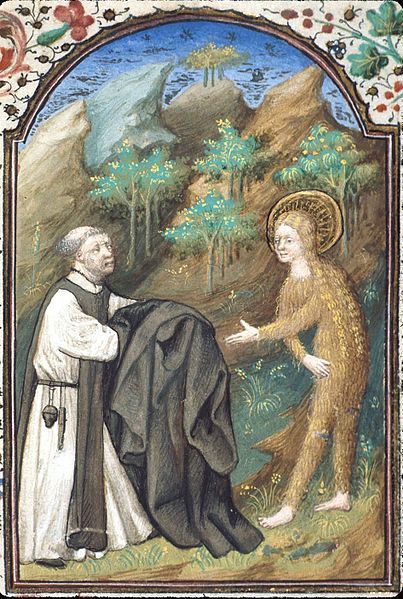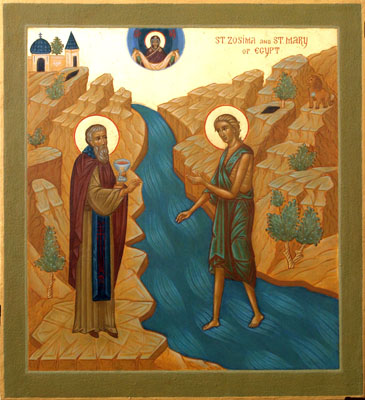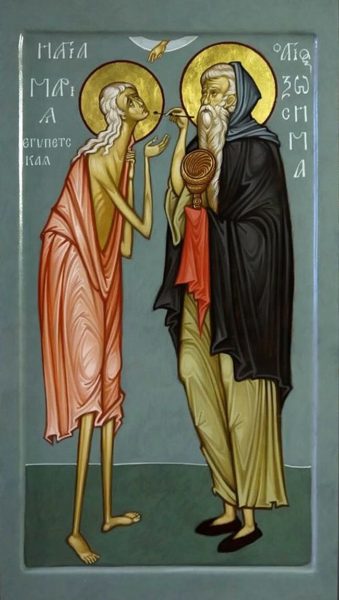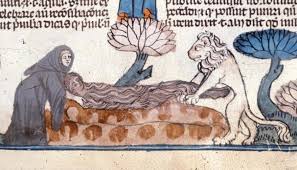
 As I mentioned in my July 22, 2018 blog post on Mary Magdalene’s feast day this year, I have been collecting pins of MM art images on my Pinterest account. It all began many years ago around 2003, when I started looking on the internet for a few images of Mary Magdalene to use in her feast day celebrations. Now of course, there has been an explosion in the availability of art images online, and my board of MM images has already grown to over 500 pins. In any case, in this collection process, I started finding unusual images of MM where she was portrayed as naked, clothed only in her long red hair. This perplexed me and I felt disconcerted that such a distinguished disciple of Jesus, in fact the Apostle to the Apostles, would be depicted this way. I could not figure out right away what was going on, but then I stumbled across similar images that are described as representations of Mary of Egypt. Out of the 160 Mary of Egypt pins that I collected, only 18 of the images actually portray her as naked, but there are some quite unusual depictions, showing her hair grown out in a way that looks like she is covered with fur. In most of these hairy images of her, she has long red hair, but there are a couple of images where it looks like she has silver dredlocks! And in almost all of the 160 images, she appears extremely emaciated, from living as a hermit in the desert.
As I mentioned in my July 22, 2018 blog post on Mary Magdalene’s feast day this year, I have been collecting pins of MM art images on my Pinterest account. It all began many years ago around 2003, when I started looking on the internet for a few images of Mary Magdalene to use in her feast day celebrations. Now of course, there has been an explosion in the availability of art images online, and my board of MM images has already grown to over 500 pins. In any case, in this collection process, I started finding unusual images of MM where she was portrayed as naked, clothed only in her long red hair. This perplexed me and I felt disconcerted that such a distinguished disciple of Jesus, in fact the Apostle to the Apostles, would be depicted this way. I could not figure out right away what was going on, but then I stumbled across similar images that are described as representations of Mary of Egypt. Out of the 160 Mary of Egypt pins that I collected, only 18 of the images actually portray her as naked, but there are some quite unusual depictions, showing her hair grown out in a way that looks like she is covered with fur. In most of these hairy images of her, she has long red hair, but there are a couple of images where it looks like she has silver dredlocks! And in almost all of the 160 images, she appears extremely emaciated, from living as a hermit in the desert.
Mary of Egypt is a saint who is not very well known in Catholic circles, but is much more familiar to Coptic and Orthodox Christians. It is not absolutely clear whether she lived in the fifth or sixth century. According to her life story, she died on April 1 which was Holy Thursday, in a year when Easter was celebrated on April 4. From this information, it is possible that she died in 443, 454, 527, 538, or 549. On the other hand, you could read her life story in such a way that she died on Good Friday, which is consistent with the Orthodox tradition that she died in 522.
 The story of Mary of Egypt goes something like this. There once was a monk named Zosimas who lived in a monastery by the Jordan River. As was the custom in that time, he went out into the desert to spend the season of Lent in prayer and contemplation. On the 20th day, he saw a figure in the distance and approached to see who it might be. It was Mary of Egypt who called him by name but turned away from him, saying that she was “a shameful naked woman.” She asked him to throw her his cloak, so that she could be covered and able to ask for his blessing. He was amazed that she knew his name, so he threw her the cloak and then begged for her blessing. She responded by saying, “Blessed is God Who cares for the salvation of our souls.” Mary turned toward the east as they were praying silently, and when he turned to look at her, she was levitating about two to three feet above the ground. He fell to the ground and begged her to tell him her life story.
The story of Mary of Egypt goes something like this. There once was a monk named Zosimas who lived in a monastery by the Jordan River. As was the custom in that time, he went out into the desert to spend the season of Lent in prayer and contemplation. On the 20th day, he saw a figure in the distance and approached to see who it might be. It was Mary of Egypt who called him by name but turned away from him, saying that she was “a shameful naked woman.” She asked him to throw her his cloak, so that she could be covered and able to ask for his blessing. He was amazed that she knew his name, so he threw her the cloak and then begged for her blessing. She responded by saying, “Blessed is God Who cares for the salvation of our souls.” Mary turned toward the east as they were praying silently, and when he turned to look at her, she was levitating about two to three feet above the ground. He fell to the ground and begged her to tell him her life story.
Mary told him that she had run away from home when she was 12 years old and had lived a sinful and lust-filled life, reveling in all kinds of earthly pleasures without feeling any shame. One day in Alexandria, 17 years after leaving home, she saw a crowd of people preparing to travel to Jerusalem. Since she had no money, she promised sexual favors to some men, if they would take her with them. When they arrived in the holy city, Mary was curious and went with a large group of pilgrims toward the Church of the Holy Sepulchre, where they were celebrating the Feast of the Exaltation of the Cross. However, when Mary got to the church threshold, she was held back by an invisible force and could not enter. After trying several times, she was tired and, gazing upon an icon of the Theotokos  (Mother of God,) she began to see that her sinful life was preventing her from entering the church. With remorse, Mary prayed to the Holy Virgin to help her get into the church, promising to be obedient to whatever would then be asked of her. She was then able to go into the church, where she venerated the relic of the True Cross.
(Mother of God,) she began to see that her sinful life was preventing her from entering the church. With remorse, Mary prayed to the Holy Virgin to help her get into the church, promising to be obedient to whatever would then be asked of her. She was then able to go into the church, where she venerated the relic of the True Cross.
When she returned to the icon on the church portico, she heard a voice that said, “If you cross the Jordan, you will find glorious rest.” Mary went immediately to the Monastery of John the Baptist on the banks of the Jordan River, where she received absolution from her sins and Holy Communion. Someone had given her some coins, so she bought three loaves of bread and crossed over the river to spend her life as a desert ascetic.
The bread fed her in the desert for several years and after that she lived only on whatever she could scavenge from the wilderness. After a long time in the desert, her clothes eventually disintegrated and therefore she suffered greatly from temperature extremes. Although she was tempted to return to her old life, she spent the next 47 years in the desert, repenting of her sins and trusting in the Mother of God to keep her safe. Ending her story, Mary of Egypt asked Zosimas to pray for her soul and not to reveal her story until after she died. She then asked him to meet her at the Jordan River the next year on Holy Thursday to bring her Holy Communion.
 Zosimas returned the next year at the appointed time, bringing her the Eucharist, and miraculously, she made the sign of the cross and walked across the surface of the Jordan River to meet him. Observing this incredible and surprising feat, Zosimas exclaimed, “Glory to You, Christ Our God, Who has shown me through this your servant how far away I stand from perfection.” He gave her Holy Communion and promised to meet her in the desert the following year at Lent.
Zosimas returned the next year at the appointed time, bringing her the Eucharist, and miraculously, she made the sign of the cross and walked across the surface of the Jordan River to meet him. Observing this incredible and surprising feat, Zosimas exclaimed, “Glory to You, Christ Our God, Who has shown me through this your servant how far away I stand from perfection.” He gave her Holy Communion and promised to meet her in the desert the following year at Lent.
Again the next year during Lent, Zosimas left the monastery and traveled into the desert, to the appointed place to meet her. There he found her lying dead, with her incorrupt body still covered by his cloak. In the sand next to her body, her name was written, with instructions for her burial. It was also written that Mary had died on that day the year before, when he had brought her Holy Communion and her body was miraculously transported to her current location. Zosimas was concerned and could not think of how to bury Mary, because he was not strong and had not brought any tools with him. Suddenly, without any warning, a lion appeared and began to dig her grave with his paws. Covering Mary’s feet with tears and kisses, they committed her to the earth with prayers. Then the lion went off into the desert and Zosimas returned to his monastery, where he related Mary’s story to his fellow monks. Her memory was preserved by oral tradition until her Vita (life story) was written down by Sophronius, the Patriarch of Jerusalem, in the seventh century, bringing glory to God and hope to sinners. She later became a saint in both the Catholic and Orthodox Churches, and her feast day is celebrated on April 1.
 Reference 1: “St. Mary of Egypt, the Righteous and a True Icon of Repentance,” blog post March 31, 2012 at http://full-of-grace-and-truth.blogspot.nl.
Reference 1: “St. Mary of Egypt, the Righteous and a True Icon of Repentance,” blog post March 31, 2012 at http://full-of-grace-and-truth.blogspot.nl.
Reference 2: “St. Mary of Egypt (for all ages,)” blog post April 1, 2014 at http://frederica.com/writings/st-mary-of-egypt-for-all-ages.html. Story written for children by A. Prince, previously posted at http://www.roca.org/OA/28/28g/htm.
Reference 3: “Hairy Mary,” British Library Medieval Manuscripts blog post, April 7, 2017, https://blogs.bl.uk/digitisedmanuscripts/2017/04/hairy-mary.html
Image 1: Icon of Mary of Egypt written by Gabriel Toma Chituc.
Image 2: Icon of Mary of Egypt written by Dr. Stéphane René.
Image 3: Detail from fifteenth century French miniature of Mary of Egypt and Zosimas, British Library Digital Catalogue of Illuminated Manuscripts, Wikimedia Commons, public domain.
Image 4: Icon of Mary of Egypt walking on the Jordan River, https://fdathanasiou.files.wordpress.com/2012/03maryzosima.jpg.
Image 5: “St. Mary of Egypt and St. Zosimas,” icon written by Maxim Shehukov, http://orthodoxartsjournal.org.
Image 6: Burial of Mary of Egypt, Smithfield Decretals Illuminated Manuscript, (Decretals of Gregory IX) Tolouse 13th or 14th century, BL Royal 10 E IV, fol. 288r.















2 Comments
Leave your reply.